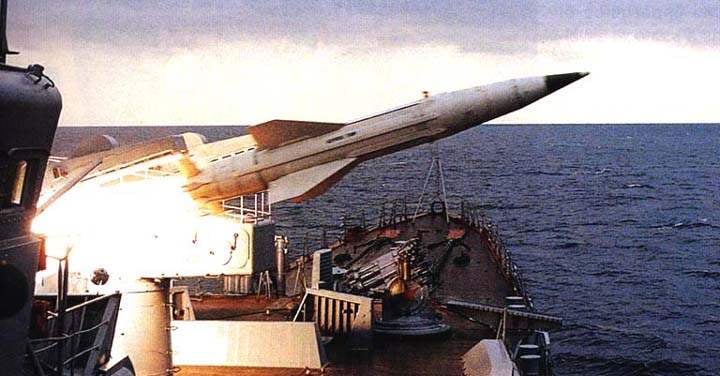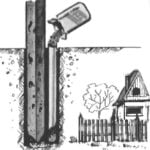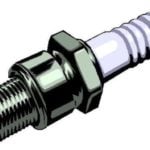 In accordance with the existing plan for the construction of the Soviet Navy in the late 1950-ies provided for the construction of a series of special vehicles, air defense PR 1126 ships and radar surveillance D. 62, the main weapon was supposed to be a universal anti-aircraft missile system M-11, designed for effective combat not only aircraft but also surface type enemy destroyers, torpedo boats and boats-submarines.
In accordance with the existing plan for the construction of the Soviet Navy in the late 1950-ies provided for the construction of a series of special vehicles, air defense PR 1126 ships and radar surveillance D. 62, the main weapon was supposed to be a universal anti-aircraft missile system M-11, designed for effective combat not only aircraft but also surface type enemy destroyers, torpedo boats and boats-submarines.
The main technical solutions adopted in the creation of a missile for this complex were predetermined by the fact that in the initial stages of development of the M-11 one of the requirements was to ensure a maximum of continuity with the complex M-1, and possible, and the unification of its elements the Anticipated unification, along with the natural desire to fit in limited amounts of ammunition cellars of the ships, determined the length of the launch of the new complex, is practically equal to the missile complex M-1 on the other hand, at the range the new complex was not to concede naval version of the medium-range SAM s-75 — M-2 “Volkhov-M” rocket-753, the experiment is set on the cruiser “Dzerzhinsky” was held at the end of 1950-ies.
Finally, the parameters of the complex M-11 was determined in the government decree of July 25, 1959, and a year later, on 22 July 1960, the need for expansion of this work was confirmed by another resolution, which also expanded the list of carriers of the new complex, including anti-submarine cruiser PR 1123.
Complex M-11 was supposed to hit aerial targets flying at speeds up to 800 m/s, at altitudes from 250 m to 20 km, and at ranges from 3 to 25 km from the ship To the same distances M-11 was supposed to hit and surface targets Simultaneously, were presented the most stringent requirements on dimensions and mass of the rocket is its length was not to exceed 6 — 6.5 meters, wingspan must be no more than 1.7 meters, weight less than a ton and a half.
The lead developer of the M-11, received the code name “Storm”, was named the NII-10 (further — NPO “Altair”), the chief designer — Mr. Volgin the Development of launchers was charged to the design team, headed by te Velkostou create the rocket for M-11, which received the designation b-611, instructed headed by P. D gruzinim by OKB-2 (hereinafter — IBC “Torch”) the First analysis of the claims made for the new missile, showed that the characteristics of In-753, yet in the mid-1950s, was considered the limit achievable, it was necessary to implement in the rocket with almost twice the smaller sizes at least as stringent customers from the Navy and insisted that in the new rockets were used only solid fuel engines Of various liquid fuels based on high-performance hydrocarbon compounds and acids, there was no question the Only thing that could work to facilitate the solution of the problem, there was a time stock in a few years was regarded as more than real, especially as the first evaluation showed that when using solid fuels, which production was mastered by the end of 1950-ies, to achieve the required characteristics of a single-stage rocket during its execution will be extremely difficult However, and the two-stage version of the b-611 significant benefits are also not provided — getting the desired range, the developers were simultaneously raised the problem of finding means of protecting ships orders from falling boosters.
Zatyagivaetsya to cut the tight knot of problems was by implementing a series of measures, including the development of a rational method of radio command guidance missiles at the target, choice of aerodynamic configuration of the missile and, of course, create the most efficient propulsion system.
In the final version of the missile b-611 weight 1833 kg, of which 125 kg were warhead was made by the normal scheme with X-shaped arrangement of the aerodynamic surfaces is the Most efficient for the rockets was named the dual-mode engine, which provided her an intense start with the short guide and maintain a high average speed.
The body of the rocket consisted of five compartments first compartment located radio and contact fuses, and antenna fuse, the second main elements of the management system, and the third battle of the Fourth compartment was a body solid rocket motor Tail section of the rocket was made in the form of a truncated cone, which housed the elements of the steering gear located around the engine nozzle with an elongated gas passage.
This layout allowed us to obtain several advantages. So, a solid propellant charge has been placed closer to the center of mass of the rocket and its burning was a smaller effect on the change in alignment of the missile during the flight the engine operating time was comparable to the time of flight of missiles at maximum range, which means that the missile could do without the use of a passive section of flight trajectory and the concomitant effects of reducing the maneuverability and control was at least as important maintaining the health of the engine housing when the rocket intensive maneuvers in the target area.

Missiles V-611 SAM “Storm”
Another novelty proposed by OKB-2, was onboard source of electricity to power equipment rocket AC and DC. Unlike predecessors, the new power source worked on solid fuel 15 Dec 1962, almost simultaneously with the release of the draft design for In-611, on the slipway Nikolaev plant No. 444 (hereinafter “the black sea plant”) was laid antisubmarine cruiser project 1123, the future cruiser “Moskva”, designed to CDB-17 under the leadership of A. Savicheva, V. And Marinich In its purpose, architecture, armament, technical means and tactical and technical data it was radically different from all ships, ever built for the Soviet Navy, and therefore attracted the attention of the leadership of the country’s Initial schedule of its construction was planned in two and a half years, by mid-1965, It required significantly accelerate the pace of works on creation of rocket-611 By the summer of 1964, the first rocket-611 was prepared for the throwing test with ground-based launchers since that time, was not yet complete equipping of the complex allocated for testing “Storm” optovogo vehicle OC-24 First catchy on the first launch took place on 30 July then it required carrying out a number of necessary modifications and research, which took almost six months. However, work schedules lagged behind not only the missile but also shipbuilders By the summer of 1964 it became clear that the completion of the “Moscow” is transferred according to the terms of approximately half a year eventually, the descent ship on the water took place only on 14 January 1965 and the end of its construction was planned in 1967 After him, the very next day after the descent on the water, was laid a second cruiser PR 1123, which received further the name “Leningrad”.
Throwing the first modified start At-611 complied with optovogo vessel OS-24 January 14, 1966 This series of tests continued until the end of January the results were also not ideal, since the beginning of 1966 still was unable to complete bench testing of the propulsion system of the launch happened its burnouts, adjusted the size and increased thermal protection.
At the same time to solve another identified problem — the shielding of the passage of radio signals from the station pointing a torch of hot gas — was performed four additional start-up, during which clarified the impact of the torch of the engine on the functioning of radio link management at various locations on-Board antennas the result was the decision to set on pylons in the tail of the rocket double antenna channel commands and channel response Now in any mutual position of the missile and ship the torch no longer interfere with getting the missile the necessary control commands.
27 Feb 1966 performed the first start-611 closed-loop control, and soon the first missile hit the target, flying on the removal of 26 km and an altitude of 10.3 km, and Another start made for moving with a high speed boat target, located at a distance of 20 km next year test M-11 continued not only on the OS-24, but on the anti-submarine cruiser “Moskva” In contrast to optovogo of the vessel it was installed two double girder launchers B-189 with storage and filing, able to accept 48 missiles, “Moscow” was equipped with two stations targeting the “Thunder” But as both anti-aircraft missile system was consistently placed in the bow, with the excess of the launchers and antenna posts of the second over the first, the huge superstructure with macto-pipe closed aft angles ranging from about +/-130 degrees from the nose as a result of the ship formed a significant “dead zone” in which “Moscow” was defenseless from the attacks of enemy aircraft To some extent this disadvantage can be compensated by the possibility of making the ship maneuver in the timely detection of targets.
Public testing of M-11 missiles V-611 were to begin simultaneously with the testing of other systems of the future flagship of the Soviet Navy and the ship In preparation for it well-established at the time of the previous weapons naval air defense systems technology firing anti-aircraft missiles carried on the run from the ground to aircraft targets, which for safety was accompanied by two interceptors, They had to finish the aircraft target in the case that it deviated from the course, and if the missiles miss or cancel firing To ensure these tests have identified a squadron of fighter planes stationed at the airfield near Feodosia However, the first firing with “Moscow” anti-aircraft missiles, even prepared in all respects, failed Fighters had to finish in the air target a few times, Soon a ship arrived, the Director of the shipyard And Gankevich, appointed a special award to the participants of the firings for each successful start, Because without a successful test of the missile complex could not be considered on completion of state tests of the ship And it started to gradually recover.
By mid-August 1967, just prior to the state tests, it remained to perform the last shooting And once again had to connect to the plant Manager an Unexpected obstacle was the upcoming Day of aviation, to which, in order to avoid accidents or disasters was banned all flights of military aircraft Gankevicha managed to get an appointment to army commander And Pokryshkin, who entered the position of shipbuilders and missile and gave permission for the fighter flights.
All of this raised tension among sailors, workers and testers that before the last shooting on the flight deck and superstructure cruisers gathered all who could, sincerely worrying about the result of such an important start, And when the first pair was launched from the ship “611’s” missile target was struck, the joy of the audience knew no bounds. State tests M-11 began in a given period of time.

Anti-aircraft guided missile b-611 ind. 4К60 SAM system M-11 “Shtorm”
During the state tests “Moscow” was held 20 rockets, including nine telemetric About a third of them went bad Once affected by shortcomings in the documentation, in three cases, failed shipboard control system and three or Four side rocket launch conducted at simulated targets, the same — on parachute targets PM-6 descending from a height of 8 km at a range of about 30 km in addition, completed two durametric volley at targets La-17, flying at the same height, but on the removal of a little more than 20 km and another two on the barge, placed on the same deletion In General, when tests confirmed the ability of the complex to hit targets at ranges from 6 km to 33.5 km in the altitude range from 100 m to 25 km it Should be noted that the launches of anti-aircraft missiles with “Moscow” has put its main objective the testing of the specific weapon of the ship, instead of the complex M-11, which still continued to be fulfilled on OC-24, and after passing the Navy first anti-submarine cruiser 25 December 1967 In the final waste form M-11 missiles received the naval designation 4К60, was adopted on 6 September 1969, Almost simultaneously with the adoption of the “Storm” into service became operational fleet and the same with “Moscow” antisubmarine cruiser “Leningrad”, during the test, which was launched eight rockets b-611, including two at simulated targets, steam — boat PR 199, and the remaining two dvuhnitochnyj volleys at targets La-17 Despite the fact that one of the missiles after launch was not controlled, both targets were shot down and the test is considered quite successful.
In the future M-11 launchers B-187 mounted on heavy avianese the cruiser “Kiev” PR 1143, the Foundation of the group which were not helicopters, as “Moscow” and “Leningrad” and the aircraft vertical takeoff and landing Yak-38 an Increase of nearly three times the tonnage compared to the helicopter allowed us to more efficiently accommodate anti-aircraft missile systems — one in the bow, the second — in feed, avoiding the presence of “dead zones” In the test vehicle on the Black sea, which lasted from 6 may to 24 October 1975 successfully conducted seven launches of missiles V-611 for parachute targets M-6 and boat-goal After almost two years, October 15, 1977 began testing the same type of “Kiev” ship “Minsk”, concluded on 18 February 1978, it was conducted eight successful launches of missiles V-611 of the ship’s shield, targets La-17M and M-6 the Last of the heavy aircraft-carrying cruisers with the “Storm” equipped “Novorossiysk”, built on improved project 11433, which had some notable differences from its predecessors in its tests held from 20 to 27 may 1982, was performed 11 launches on the ship’s shield, targets La-17M and M-6.
Complex M-11 was upgraded twice in 1969 introduced the “Storm-M”, equipped with advanced multifunction stations “Thunder-M”, and in 1986 — “Storm-N”, the characteristics of which ensured the defeat of aerodynamic targets at low altitudes. In addition, in the early 1970-ies, attempts were made deep modernization of the “Storm”, bringing its maximum range up to 50 km But this time its main developers were loaded with works created to replace the s-300F and in order not to distract the designers from this work, from the radical modernization of the “Storm” refused.
In General, over the years, “Storm” has proved itself on the positive side, becoming, according to the characteristics of the commander of the Soviet Navy s G Gorshkov, the backbone of air defense of the fleet further, since “Storm” was set mostly on ships, deprived of a missile impact, it has become the most important anti-ship weapons major surface ships of the Navy built in the late 1960s and 1970s years, with the exception of aircraft-carrying heavy cruisers.
It was generally made 44 complex “Storm” installed on the OS 24 and 22 warships But by the beginning of the XXI century in the ranks of them there are only two ship M-11 PR 1134B — “Kerch” and “Ochakov”.
The main characteristics of the missiles 4К60
The height of the flight of target, m
minimum …………………………………………………………………………..100
maximum…………………………………………………………………………..25 000
The maximum speed intercept air targets, m/s….800
Firing range, km minimum……………………………………….3
maksimalnaya…………………………………………………………………………..33,5
The maximum flight speed of rocket, m/s……………………………….1200
The speed of the missile in the affected area, m/s………………………….650 800
The mass of high-explosive
warhead, kg………………………………………………………………………..125
Launch weight, kg …………………………………………………………………1844
Length of missile, mm……………………………………………………………………..6165
The diameter of the rocket body, mm……………………………………………………..655
Wingspan, mm………………………………………………………………….1700
V. KOROVIN



